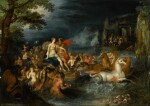
Property from a European Private Collection | 歐洲私人收藏
Frans Francken the Younger
Neptune and Amphitrite |《涅普頓與安菲特里忒》
Auction Closed
December 10, 06:47 PM GMT
Estimate
60,000 - 80,000 GBP
Lot Details
Description
Property from a European Private Collection
歐洲私人收藏
Frans Francken the Younger
小弗蘭茲・弗蘭肯
Antwerp 1581 - 1642
Neptune and Amphitrite
《涅普頓與安菲特里忒》
signed lower right: f·franck · iN F fe
款識:藝術家簽名f·franck · iN F fe(右下)
oil on oak panel
油彩橡木畫板
53.6 x 75.2 cm.; 21 1/8 x 29 5/8 in.
53.6 x 75.2 公分;21 ⅛ x 29 ⅝ 英寸
Giovanni Andrea de Marinis, Marchese di Genzano, Naples, before 1824;
By whom bequeathed to his son-in-law, Giuseppe de Sangro, 3rd Prince of Fondi (1776–1837), Palazzo del Principe di Fondi, Naples;
Thence by descent in the De Sangro family collection, Naples, until 1895;
Their sale, Naples, Palazzo Fondi, 22 April – 1 May 1895 (this lot, 1 May 1895), lot 721;
Sasso collection, Rome, by 1946;
Anonymous sale, New York, Sotheby's, 7 June 1984, lot 71;
With Galerie Robert Finck, Brussels, by 1985;
From whom acquired, in 1987, by the present owner.
Catalogo de' quadri componenti la galleria del Principe di Fondi. Strada Fontana Medina n. 24, 1860-90, Archivio Centrale dello Stato, Min. P.I., Dir., Gen. AA.BB.AA., Div. Musei, Gallerie e Pinacoteche, Naples, b. 250, fasc. 117–121, listed in the 'Prima stanza a fronte di strada dopo la galleria', no. 182.7;
O. Turchetti, Napoli e il suo congresso, Napoli al cospetto della civiltà contemporanea, Pistoia 1846, p. 183;
S. D’Aloe, Naples ses monuments et ses curiosités, Naples 1847, p. 330;
Mostra di antiche pitture Olandesi e Fiamminghe, exh. cat., Rome 1946, pp. 10-11, cat. no. 5, reproduced;
U. Härting, Studien zur Kabinettbildmalerei des Frans Francken II. 1581–1642. Ein repräsentativer Werkkatalog, Hildesheim 1983, no. A213a;
U. Härting, Frans Francken der Jüngere (1581–1642). Die Gemälde mit kritischem œuvrekatalog, Freren 1989, pp. 99 and 312, no. 284, reproduced;
G. Manieri Elia, 'La quadreria napoletana de Marinis-de Sangro dall’influenza del classicismo romano al dissolvimento del collezionismo aristocratico', in E. Debenedetti, Collezionismo e ideologia: mecenati, artisti, teorici dal classico al neoclassico, Rome 1991, p. 333, no. 182.7 (1860-90 inventory);
M. Savarese, 'La collezione de Sangro dei principi di Fondi in tre inediti inventari di famiglia: da quadreria seicentesca a moderna raccolta di arti decorative', in Napoli nobilissima, July 2006, vol. VII, 5/6, pp. 203 and 206 (1824 inventory).
The Triumph of Neptune and Amphitrite was a subject clearly favoured by Francken and his contemporaries, as he treated the theme in at least twenty-two iterations and in a number of different ways. The present composition is one of three versions of this design; the other two paintings, of similar dimensions, are in the Galleria Palatina, Florence (inv. no. 1068) and the Kunstmuseum, Göteborg (inv. no. 327).1
The King and Queen of the Sea are pictured here riding a shell-like chariot pulled by six sea-horses, or hippocamps, with a procession of Tritons and Nereids in their wake, carrying fish, shells, and other treasures of the deep. Other gods dine at a feast in a grotto on the far shore. In comparison with the other versions, the foreground in the lower right corner of this panel is slightly more spacious to allow for the depiction of finely-executed reeds and, similar to those in the Galleria Palatina painting, a particularly beautiful collection of delicately rendered shells.
Provenance
The Sangro collection was one of the most famous and highly-regarded in 19th-century Naples, research into which has been made possible only in relatively recent years, following the discoveries of two 19th-century inventories in the Neapolitan State Archives (see Literature). Giovanni de Marinis, Marchese di Genzano, was from an aristocratic family of Genoese origin, and a relation of the Cattaneo and Grimaldi families; his daughter, Maria Costanza's marriage to Giuseppe de Sangro marked the end of the Marinis line, and the transferral of the collection, begun by Giangiacomo de Marinis (1698–1765) Giovanni's uncle, to the Sangro family. Amongst some 300 paintings were works by Correggio, the Carraccis, Reni, Guercino, Sassoferrato, Titian, Tintoretto, Giordano, Cranach, Fabris, Volaire and Tischbein, along with an extensive collection of porcelain, maiolica, bronzes, and tapestries; the Sangro sale in 1895, necessitated by financial difficulty, comprised 749 lots.
1 See Härting 1989, pp. 312–13, nos 283–85, all reproduced.
You May Also Like










